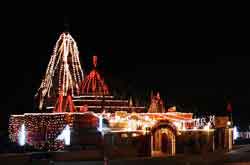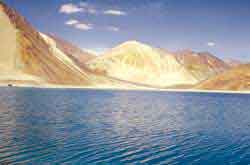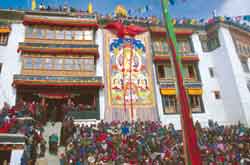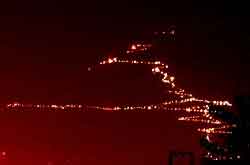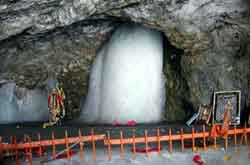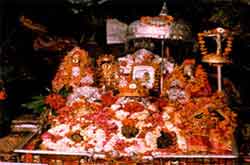Hemis and Jesus
An article by M. Ashraf, former Director General of Tourism, Jammu & Kashmir
One of the adventures I have been following for over 30 years is the story of Jesus visiting Kashmir, Ladakh, and Tibet. I made a number of trips to Ladakh to verify the basis of the story which has now assumed huge proportions in the west.
The myth about the tomb of Jesus in Kashmir has been circulating for a long time. A large number of books, articles, and research papers have been written on the subject. Rozabal, Khanyar in Srinagar is a big attraction for everyone interested in the mystery of the missing years of the life of Jesus Christ. The Shrine of Roza Bal which is the site of the supposed tomb of Jesus in Khanyar, Srinagar has been visited by a large number of journalists, research scholars, and even some religious teams deputed by a number of Christian Organisations. Even fiction writers like Von Denikin have also visited the site.
However, in recent years it has caught the imagination of the foreign electronic media and dozens of documentaries have been made on the subject. Most of these documentaries can be seen on the internet on the YouTube website. The documentaries include a three part one made by BBC.
The reason for so much interest in the subject is the total lack of information about the life of Jesus from the age of 12 to 28. Bible does not mention anything about this nor are any records available anywhere else regarding this missing period.
I have been personally following the story for last more than three decades. In fact, I was first introduced to the subject by Prof. Fida Hassnain, the former Director Archives. He has written a number of books on the subject. The latest one, “Beyond the Da Vinci Code” has been co-authored by him with Suzanne Olson. The myth of Jesus in Kashmir in recent times was first given wide exposure by the Ahmadiya Sect when Khawaja Nazir Ahmad of Woking Muslim Mission in U.K. wrote his book “Jesus in Heaven on Earth”.
However, the connection of Jesus to Kashmir was actually found by a Russian Traveller Nicolas Notovich who stumbled on a Tibetan Scroll in the Hemis Monastery of Ladakh in 1887.
While in Ladakh he was told by the abbot of a Buddhist monastery that manuscripts recording the life of Jesus were to be found in Lhasa-at that time absolutely closed to any "white" man, as was the entire country of Tibet. Despite this prohibition, Notovich determined to force his way to Lhasa in search of the rumored records. While still in Leh, the capital of Ladakh, Notovich visited the monastery of Hemis and spoke with its abbot.
When Notovich asked the abbot if he knew anything of Isha, he was amazed to receive this reply: "The name of Isha is held in great respect by the Buddhists. But little is known about him save by the chief lamas, who have read the scrolls relative to his life....Among [the manuscripts of our monastery library] are to be found descriptions of the life and acts of the Buddha Isha, who preached the holy doctrine in India and among the children of Israel and who was put to death by the pagans, whose descendants have since embraced the tenets he then propagated……The documents [about Isha] brought from India to Nepal and from Nepal to Tibet concerning his existence are written in the Pali language and are now in Lhasa. But a copy in our language-that is, the Tibetan-exists in this monastery”.
Notovich tried his best to persuade the lamas to help him in translating the scrolls but they refused. However, while returning to Leh he slipped from his horse and broke his leg. The lamas carried him back to the monastery where he was forced to remain bed ridden for few months.
Due to his predicament the lamas became friendly to him. Taking advantage of his enforced stay in the monastery, Notovich asked that the manuscript on the life of Jesus be brought to him and his interpreter be permitted to read it out to him in Russian. This was done, and he wrote down the interpreter's words.
On his return, Notovich showed the manuscript to cardinal in Rome as well as to Russian Orthodox Church but all advised him not to print it as it would cause many problems. However, Notovich got the manuscript published as, “The Unknown Life of Jesus Christ”.
There was uproar all over Europe about the blasphemous book. A number of missions were sent to Hemis to verify the existence of the document. Among those who visited the Hemis and testified to the existence of the scrolls is Elizabeth Caspari, the educationist. She was shown the manuscript by the lamas.
Dr. Nicholas Roerich, the renowned scholar, philosopher, and explorer, traveled in Ladakh and was also shown the manuscript and assured by the monks that Sri Isha had indeed lived in several Buddhist monasteries during His "lost years." He wrote about his own viewing of the scrolls in his book The Heart of Asia.
Swami Abhedananda, a direct disciple of Sri Ramakrishna Paramhansa and Vice-President of the Ramakrishna Mission went to the Hemis monastery in 1922 and was shown the manuscript. The lama who showed him the scrolls further told the Swami that the manuscript he was showing him was a translation of the original which was kept in the library of the monastery of Marbour near Lhasa.
The lama, who knew English, read out some of the verses in English, demonstrating that Notovich's translation was true and not a fabrication. He further said that the original text was written three or four years after the crucifixion, being compiled from the remembrances of those who had met Jesus, as well as the reports of some merchants who had actually witnessed the crucifixion.
There were several other people who have certified the existence of the scrolls. Robert Ravicz, a former professor of anthropology at California State University at Northridge, visited Himis in 1975. A Ladakh physician he met there spoke of Jesus' having been there during His "lost years."
In the late 1970s Edward Noack, author of Amidst Ice and Nomads in High Asia, and his wife visited the Hemis monastery. A monk there told him: "There are manuscripts in our library that describe the journey of Jesus to the East."
Toward the end of the twentieth century the diaries of a Moravian Missionary, Karl Marx, were discovered in which he writes of Notovitch and his finding of scrolls about "Saint Isha." (Notovitch also claimed that the Vatican Library had sixty-three manuscripts from India, China, Egypt, and Arabia-all giving information about Sri Isha's life.)
However, there have been many attempts at denying the total existence of these and it has also been stated that the whole thing is a hoax. Vatican has been extremely worried as it completely changes the entire discourse about the life of Jesus Christ and associates his teachings with the wise men of the east. For a long time no one has been able to see the scrolls in spite of several efforts.

